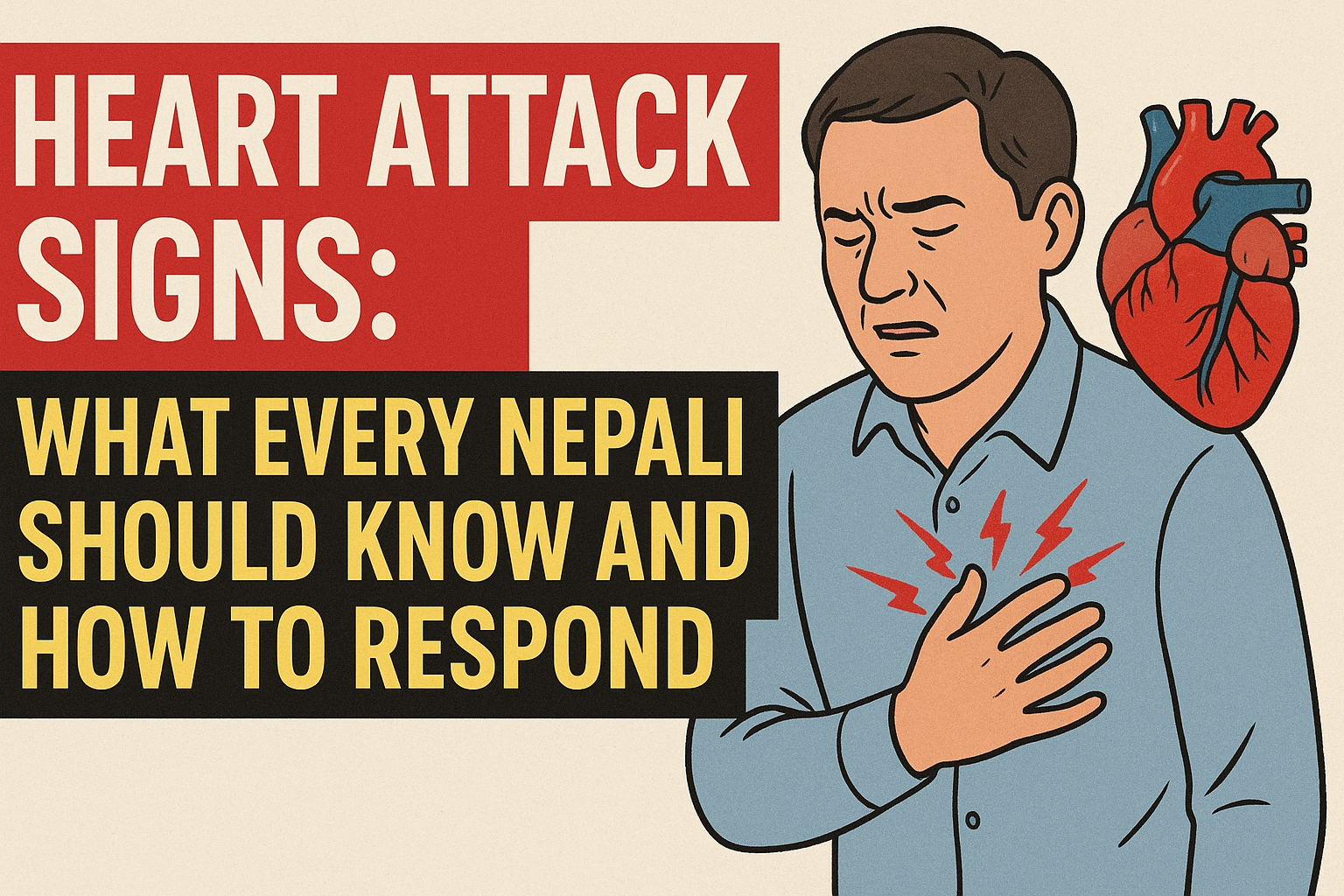A comprehensive guide on heart attack tailored for Nepal’s unique healthcare landscape
Heart Attack – The Silent Threat in Nepal
Cardiovascular disease has become the leading cause of death in Nepal, claiming more lives than accidents, infections, or other diseases. Whether you live in bustling Kathmandu, the hills of Pokhara, or remote mountain villages, knowing these signs could save your life or the life of someone you love.
🚨 Immediate Warning Signs – लक्षणहरू
Classic Symptoms:
- Chest pain or pressure – Often described as an elephant sitting on your chest
- Pain radiating to arms – Especially the left arm, but can affect both
- Jaw, neck, or back pain – Often mistaken for dental problems
- Shortness of breath – With or without chest discomfort
- Cold sweats – Sudden, profuse sweating without physical exertion
- Nausea or vomiting – Particularly common in women
- Dizziness or lightheadedness
Women’s Symptoms (Often Different):
- Extreme fatigue (like the worst flu ever)
- Subtle chest discomfort rather than sharp pain
- Upper back or shoulder pain
- Unusual shortness of breath during daily activities
Symptoms Often Ignored in Nepal:
- “Gas ko problem” – What feels like severe indigestion might be your heart
- Sudden weakness – Especially during physical work or climbing stairs
- Unexplained anxiety – A sense of impending doom
⚡ IMMEDIATE ACTION PLAN
First 5 Minutes:
- Call 102 (Nepal’s emergency number) or go to nearest hospital immediately
- Chew an aspirin (if available and not allergic) – helps thin blood
- Sit down and rest – Don’t lie flat; keep upper body elevated
- Loosen tight clothing around chest and neck
- Stay calm – panicking increases heart workload
While Waiting for Help:
- Note the time symptoms started – critical for treatment decisions
- Prepare medical history – list of medications, allergies, previous heart problems
- Have someone stay with you – never be alone during a suspected heart attack
🏥 Nepal’s Healthcare Reality: Know Your Options
Major Hospitals with Cardiac Care:
- Kathmandu: Shahid Gangalal Heart Center, TUTH, Norvic, Grande
- Pokhara: Manipal Teaching Hospital, Western Regional Hospital
- Biratnagar: Nobel Medical College, Birat Medical College
- Bharatpur: Bharatpur Hospital, College of Medical Sciences
If You’re in Remote Areas:
- Contact local health post immediately – they can provide initial care and arrange transport
- Call helicopter rescue services – Mountain Rescue Association: +977-1-4411072
- Know your nearest airstrip for emergency evacuations
- Keep emergency numbers handy in your mobile phone
🔍 Risk Factors Common in Nepal
Traditional Diet Concerns:
- High salt intake – dal-bhat, gundruk, pickles
- Trans fats – from deep-fried foods, market snacks
- Limited fresh vegetables in some regions during monsoon/winter
Lifestyle Factors:
- High altitude living – increased strain on heart
- Physical labor without conditioning – sudden intense activity
- Smoking bidis/cigarettes – extremely common risk factor
- Stress from poverty/migration – economic pressures affect heart health
- Lack of regular exercise – especially in urban areas
Genetic Predisposition:
- South Asians have higher risk for early heart disease
- Family history of heart attacks before age 55 (men) or 65 (women)
📱 Emergency Contacts – Save These Numbers Now
EMERGENCY SERVICES:
• Nepal Police: 100
• Emergency/Ambulance: 102
• Nepal Red Cross: 4270650
CARDIAC EMERGENCIES:
• Shahid Gangalal Heart Center: 4371322
• TUTH Emergency: 4412303
• Helicopter Rescue: 4411072
FAMILY DOCTOR: ________________
LOCAL HOSPITAL: ________________
🏃♂️ Prevention Tips for Nepali Lifestyle
Dietary Changes:
- Reduce salt in dal, curry, and pickles
- Choose brown rice over white rice when possible
- Eat more seasonal vegetables – even dried/preserved during off-season
- Limit deep-fried snacks and street foods
- Drink green tea instead of excessive milk tea with sugar
Physical Activity:
- Walk on hilly terrain – natural cardio workout
- Use stairs instead of elevators in cities
- Participate in community sports – football, volleyball
- Traditional activities – carrying water, farming work (in moderation)
Manage Stress:
- Practice meditation or prayer – already part of many Nepali traditions
- Maintain social connections – strong family/community bonds
- Get adequate sleep – especially important at high altitudes
💊 Medications and Medical History
Keep This Information Ready:
- Current medications (including traditional medicines)
- Known allergies
- Previous heart problems or surgeries
- Blood pressure readings
- Diabetes management
- Contact for your regular doctor
Basic Heart-Healthy Medications to Discuss with Doctor:
- Low-dose aspirin (if recommended)
- Blood pressure medications
- Cholesterol-lowering drugs if needed
🎯 Remember: Time = Heart Muscle
The sooner you get treatment, the more heart muscle can be saved. In Nepal’s challenging geography, every minute counts even more. Don’t wait for symptoms to get worse – act immediately.
“Better to be embarrassed in an emergency room than dead at home.”
📋 Quick Reference Checklist
Print this and keep in your wallet, kitchen, and workplace:
□ Emergency numbers saved in phone
□ Know route to nearest hospital
□ Keep aspirin accessible
□ Medical history documented
□ Family members know warning signs
□ Transportation plan for emergencies
□ Insurance/payment method ready
This guide is for educational purposes and should not replace professional medical advice. Always consult with healthcare providers for personalized medical guidance.
Share this guide with your family, friends, and community. A life saved could be your own.
